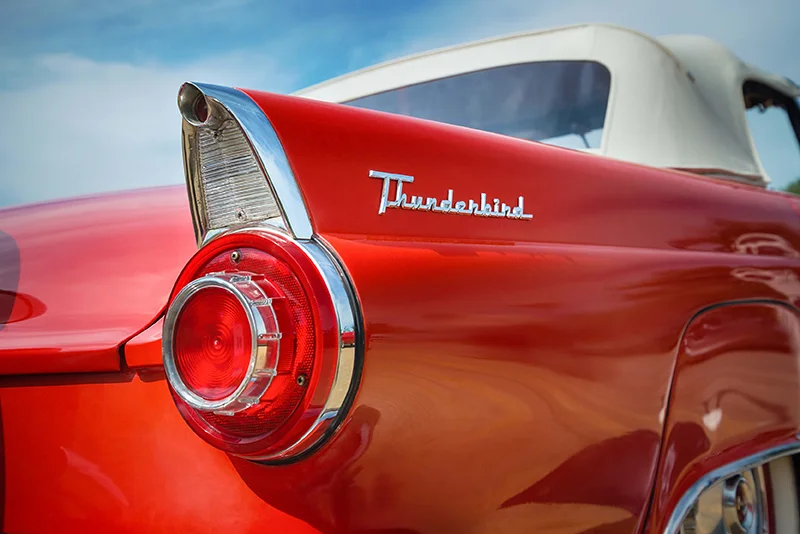While everyone has their favourites when it comes to the best classic car models, the legendary Ford Thunderbird certainly has quite the sizable fan base.
While the name ‘Ford’ is often associated with the family style sedans that we see on an everyday basis right here in Australia, in a different time the Ford Motor Company pioneered vehicles that partnered innovation, practicality and style. So much so, that Ford Motor Company founder Henry Ford is now regarded as the pioneer of the assembly line mode of production. In turn, this revolutionised the automotive industry, and ultimately helped Ford to sell millions of cars around the world.
However, after the death of Henry Ford, the company was determined to retain its status as an automotive titan in the United States marketplace. It wasn’t long until the 1950’s arrived, and Americans in particular were jubilant at the prospect of no war, higher incomes and a better overall lifestyle. The major car production firms at the time were all too aware of this, and began to pay serious attention when it came down to delivering the people what they wanted – fast cars, without sacrificing comfort.
As a means to meet this demand and keep up with the competition, the company unleashed a medley of historic automotive legends, one of which being the Ford Thunderbird.
The Birth Of The Ford Thunderbird
Needless to say, the 1950’s were an exciting time to be in the business of buying, selling and making cars. An entire generation had returned home from the war, and brought daydreams of the European lifestyle home with them. When it came to cars, style and speed somehow managed to blend together, and American automakers were scratching their heads as to how to replicate this.
While Chevrolet were already enjoying the runaway success of the Corvette, the team at Ford were at the drawing board night and day to release a sports car of their own.
As such, in 1953 a smaller two-seater sports roadster was developed at the behest of Henry Ford II – the grandson of Ford founder Henry Ford. Dubbed the ‘Vega’, the completed one-off generated interest at the time, but had insufficient power under the hood, European looks, and a correspondingly high cost. As a result, it never proceeded to production, but it did form the foundations of the first Ford Thunderbird.
The Thunderbird was similar in concept, but was considered to be far more American in style, more luxurious, and less sport-oriented. In essence, it was designed to be a flashy and luxurious machine, but had the V8 power to back all that up with proper muscle.
Under rapid development, the Thunderbird went from idea to prototype in less than twelve months, and was unveiled to the public at the Detroit Auto Show in 1954. On the outside, the new Ford Thunderbird was a two-seat design, available with a detachable glass-fiber hardtop and a folding fabric top. Though sharing some design characteristics with other Fords of the era such as single, circular headlamps and somewhat modest tailfins, the Thunderbird was sleeker in shape. It also featured a hood scoop, and speeds of up to 240 km/h not yet seen in any other Ford models. With a price tag of between $2,695 and $4,000 the vehicle was an immediate hit, with buyers describing the car as a “morale builder that is real fun and sport to drive.”
Then Thunderbird remains one of the most popular vehicles of the decade, and went on to see a massive eleven generations released, with the latest being just a few short years ago in 2005. The vehicle has since left a legacy for its speed, agility, and later its luxury and comfort. The Thunderbird, or ‘T-Bird’ has also been referenced in pop culture many times, showing it’s cultural significance to Americans in particular. Ultimately, the Ford Thunderbird went a long way in showing Ford’s ability to carve out its own niche and build something unique that was completely in a league of its own when compared to the competition.
Getting Your Hands On A Classic Car
As a piece of American history, a social experience and even as an investment opportunity, owning a classic car has been on the bucket list for many car lovers young and old – but where do you find one?
Finding a fellow vintage auto enthusiast can feel a bit like finding a needle in a haystack, but rest assured that Classic’s Garage understands the thrill more than most. Having spent forty years collecting anything and everything from matchbox cars to hub caps, he’s successfully followed his passion to source, collect and stock beautiful and low mileage classic automobiles from around the world. With extensive experience in the automotive industry, it was only a matter of time before Wayne expanded on his love of vintage, iconic vehicles to share his knowledge and passion with the public.
Although his passion is for automobiles built before 1978, with a particular love for Buicks, Cadillacs, Lincolns, Oldsmobiles and even Fords, Wayne is just as passionate about the stories of the owners. Just like the cars, he has found that his fellow classic car enthusiasts all have wildly different attractions and logic behind their passion or hobby, and this often translates into how the car is presented. If it’s even remotely different, rare or just plain unusual, Wayne will overcome the relevant logistical and geographical challenges of bringing the cars to his showroom in Australia.
Classic’s Garage is a showroom conveniently located at Seventeen Mile Rocks, that specialises in the restoration and sales of vintage automobiles. In fact, he’s got a medley of fully restored models in stock right now, which can be viewed online via Wayne’s Collection. If you’re on the hunt for Brisbane classic cars – quite simply, Wayne is your man. If you would like to arrange a viewing or inspect any other of our classic vehicles, please get in touch with us today.

